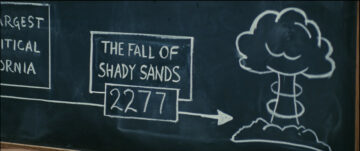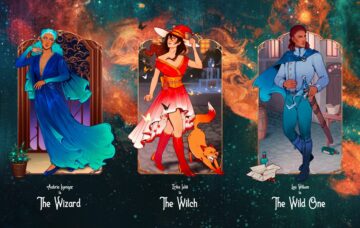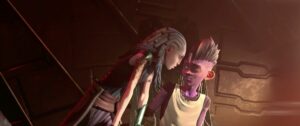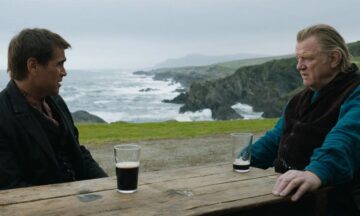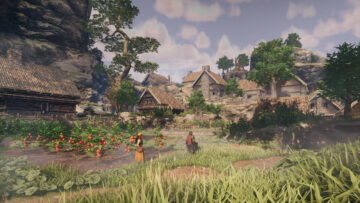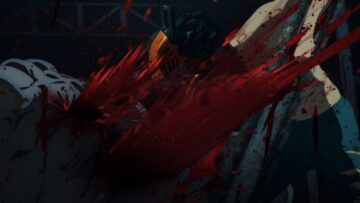The new Idris Elba movie Beast is a lean, propulsive creature feature, the kind of efficient man-versus-nature horror story that ladles on the scares, then wraps before the conceit gets old or overstretched. In the film, Elba plays a widower and father of two who has to protect his children from a man-eating lion in South Africa. It’s a comparatively small, intimate movie in scope and character, more like Crawl or Prey than like the Jurassic Park films it’s openly referencing.
For those who prefer to see their lion-gone-rogue stories (and their Steven Spielberg homages) playing out on a more majestic, ambitious scale, though, Beast is an excellent reminder to revisit the 1996 adventure thriller The Ghost and the Darkness, another story where the intellectual power of human prey has a hard time matching up to the physical power of a big veldt predator. As a horror story, The Ghost and the Darkness is surprisingly tense and bloody. But as a character study that actually invests in its characters as people, rather than leaving them as tick marks on a “death by numbers” checklist, it’s particularly well-crafted, in a way that’s familiar from a completely different Spielberg blockbuster.
The Ghost and the Darkness is nominally a historical epic based on actual events in 1898 Kenya, where two lions terrorized a British railroad camp on the Tsavo River for nearly a year, killing dozens of workers. British Lt. Col. John Henry Patterson — played in the film version by Val Kilmer — eventually wrote a book about the events, The Man-Eaters of Tsavo, in which he claimed the lions slaughtered more than 130 people, though that total was later heavily disputed. What isn’t disputed is that the lions were uncharacteristically bold, working together to hunt, and raiding the camp during the daytime — all unusual behavior for male lions, who normally leave the hunting to their pride’s females.
Image: Paramount Pictures
Screenwriter William Goldman (The Princess Bride) takes plenty of dramatic advantage of the anomalies in the lions’ behavior, and plenty of historical license with the story, all in the interest of bigger and more colorful action. Patterson is sent to Kenya by Robert Beaumont, a ruthless aristocrat and colonialist (played with mustache-twirling evil glee by Tom Wilkinson) determined to beat other countries in building railway trade routes across east Africa. That means bridging the Tsavo, a task Patterson believes he can handle because of similar experience overseeing bridge construction in India. He confidently says goodbye to his pregnant wife, Helena (Emily Mortimer, giving a small role her full energy), certain he’ll be back home in time to see his child born.
From the start, Patterson is a game and winning protagonist, willing to listen to and learn from his Kenyan camp overseer Samuel (John Kani, who went on to play Black Panther’s father T’Chaka in the Marvel Cinematic Universe), and boyishly excited by African wildlife. When he reaches the camp, he’s immediately beset by problems: tensions between the Hindu and Muslim workers imported from India, tensions between his bright young evangelical aide de camp Angus (Brian McCardie) and the cynical local doctor, Hawthorne (Bernard Hill). And then the first lion attack happens, and the African and Indian workers all sullenly look to him, as the white man in charge, to solve it.
The Ghost and the Darkness isn’t a movie about race, but it’s far franker than most adventure movies about the cost of British colonialism and the entirely reasonable class and cultural resentment underlying the railway project. And it isn’t a movie about manhood and masculinity, but Goldman’s script finds familiar threads in these characters — the need to prove themselves and make names for themselves, the jockeying for dominance that relaxes into unspoken trust or distrust, the way shared peril becomes a bonding experience. In that regard, The Ghost and the Darkness is one of the best character pieces of its type since Spielberg’s Jaws.
Goldman openly takes Jaws as a structural model, with many of the story’s basic beats mimicking Spielberg’s masterpiece: the series of escalating deaths perpetrated by a barely seen creature, the killing of an unrelated beast that’s taken as a sign that the threat is over, the late-night drinking-and-bonding session marked by a grim monologue and undercut by equally grim humor. Where Jaws introduces Quint (Robert Shaw) as the shark expert hired to take over the situation when things get serious, The Ghost and the Darkness brings in fabled hunter Charles Remington (Michael Douglas) in a similar role, and with a similarly dramatic, memorable introduction.
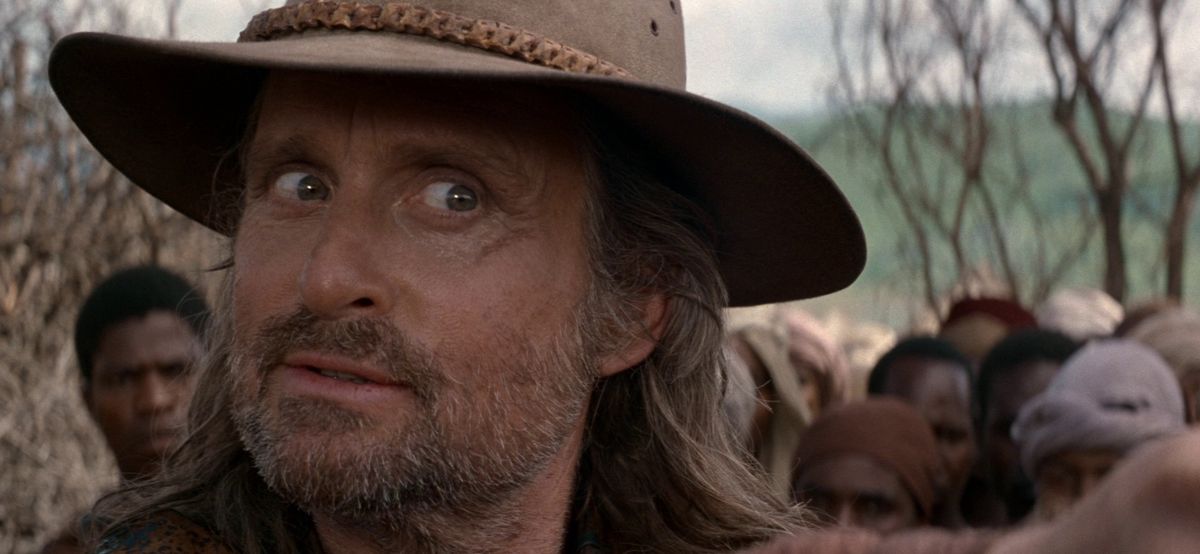
Image: Paramount Pictures
Plenty of movies have imitated Jaws over the years, usually copying the animal attacks and leaving out the memorable character dynamics. The Ghost and the Darkness is one of the very few movies that gets the alchemy right. Remington is a tragic obsessive who doesn’t enjoy killing, but finds his services in demand because he’s so good at it. Patterson is an idealist who truly believes in his work — “What better job in all the world than build a bridge?” he says at one point, watching the labor under way. Samuel is a pragmatist caught between the white outsiders’ ambition and the camp he manages. Even Angus, Hawthorne, and other minor characters, like the proud Indian overseer Abdullah (Om Puri) and his African counterpart Mahina (Henry Cele) are given prominent roles to play.
But all this character work would feel dry and literary without the movie’s pulp-thriller energy, which lays a visceral, urgent feel atop the Bridge on the River Kwai-style literary ambitions. Director Stephen Hopkins uses real lions whenever possible, and apart from a few gimmicky shots using dummies, their physical interactions with fragile human bodies look realistic and graphic. They’re genuinely intimidating, even if Hopkins and Goldman do fall into the familiar man-versus-nature movie trap (also seen, frankly, in Jaws) of giving their animals human-level cunning and malice, to the point where the railroad workers’ belief that the lions are actually demons starts to make some sense.

Image: Paramount Pictures
For all the historical epic qualities in The Ghost and the Darkness — Vilmos Zsigmond’s majestic shots of skies and fields, the focus on a packed camp full of teeming human endeavor, Jerry Goldsmith’s pounding score — the film also embraces purely corny horror-movie tropes, from a ludicrous fake-out dream sequence to first-person POV shots of what it’s like to be killed by a lion.
And for the most part, they’re efficient and effective filmmaking. A certain amount of buy-in for the over-the-top aspects of the movie is necessary from the start: Historians think Patterson was a bit of a fabulist who exaggerated the threat of the lions to burnish his own legacy, and this film goes even further into the realm of fantasy to tell its story. It plays up the natives’ superstitions about the lions as a malevolent force, but as much as anything else, it’s a movie about a 19th-century white man’s superstitions about Africa, and a 20th-century audience’s imagination about what it’s like to be prey.
It’s also a sly and effective thriller, though, one that uses a huge cast, practical effects, and Val Kilmer’s ’90s Boy Scout charm to ground what could be another trashy when-animals-attack movie in the realm of Shark Night or Lake Placid. The Ghost and the Darkness has been overlooked and underrated over the years, but in an era that appreciates pulp cinema for its own gleefully cheesy values, this movie represents a fairly unique marriage between lowbrow creature feature and highbrow historical epic. It has a lot more texture than a lot of modern beast-on-the-loose thrillers — and a lot more teeth, too.
The Ghost and the Darkness is available for digital rental on Amazon, Vudu, and other digital services. It is available on some On Demand services.


